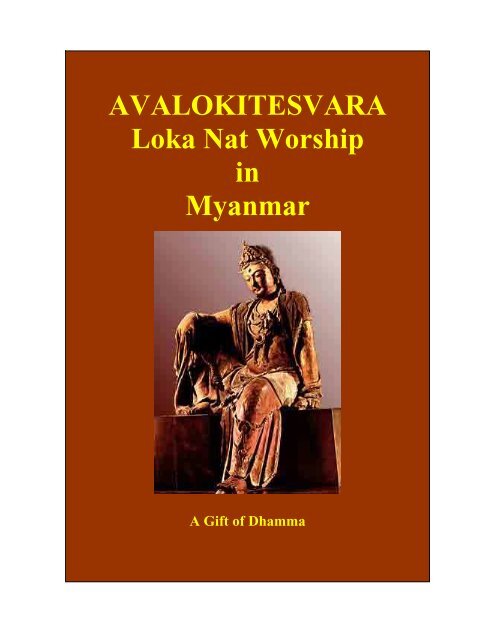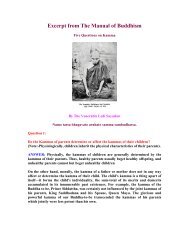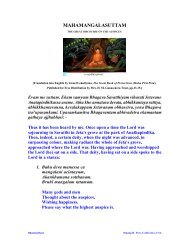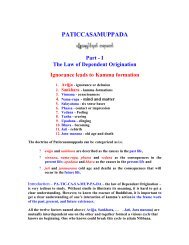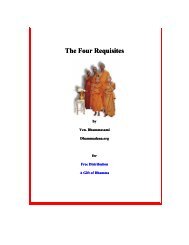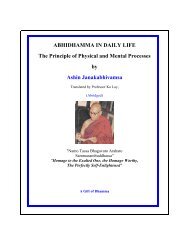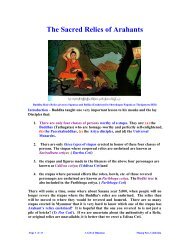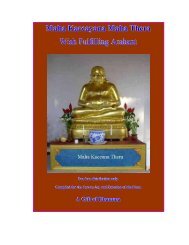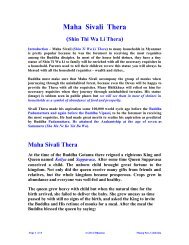AVALOKITESVARA Loka Nat Worship in Myanmar
AVALOKITESVARA Loka Nat Worship in Myanmar
AVALOKITESVARA Loka Nat Worship in Myanmar
You also want an ePaper? Increase the reach of your titles
YUMPU automatically turns print PDFs into web optimized ePapers that Google loves.
<strong>AVALOKITESVARA</strong><br />
<strong>Loka</strong> <strong>Nat</strong> <strong>Worship</strong><br />
<strong>in</strong><br />
<strong>Myanmar</strong><br />
A Gift of Dhamma
<strong>AVALOKITESVARA</strong><br />
<strong>Loka</strong> <strong>Nat</strong> Tha <strong>Worship</strong><br />
In<br />
<strong>Myanmar</strong><br />
“(Most venerated and most popular Buddhist deity)”<br />
Om Mani Padme Hum....<br />
Page 2 of 12 A Gift of Dhamma Maung Paw, California
Bodhisatta <strong>Loka</strong> <strong>Nat</strong><br />
(Buddha Image on her Headdress is Amithaba Buddha)<br />
<strong>Loka</strong> <strong>Nat</strong>, <strong>Loka</strong> Byu Ha <strong>Nat</strong> Tha <strong>in</strong> <strong>Myanmar</strong>; Kannon, Kanzeon <strong>in</strong><br />
Japan; Ch<strong>in</strong>ese, Kuan Y<strong>in</strong>, Guanshiy<strong>in</strong> <strong>in</strong> Ch<strong>in</strong>ese; Tibetan, Spyan-rasgzigs<br />
<strong>in</strong> Tabatan; Quan-am <strong>in</strong> Vietnamese<br />
Page 3 of 12 A Gift of Dhamma Maung Paw, California
Introduction: Avalokitesvara, the Bodhisatta is the most revered Deity <strong>in</strong><br />
<strong>Myanmar</strong>. <strong>Loka</strong> <strong>Nat</strong> is the only Mahayana Deity left <strong>in</strong> this Theravada<br />
country that <strong>Myanmar</strong> displays his image openly, not know<strong>in</strong>g that he is the<br />
Mahayana Deity appear<strong>in</strong>g everywhere <strong>in</strong> the world <strong>in</strong> a variety of names:<br />
Avalokitesvara, Lokesvara, Kuan Y<strong>in</strong>, Kuan Shih Y<strong>in</strong> and Kannon. The<br />
younger generations got lost <strong>in</strong> the translation not know<strong>in</strong>g the name <strong>Loka</strong> <strong>Nat</strong><br />
means one and the same for this Bodhisatta known <strong>in</strong> various part of the world<br />
as Avalokitesvara, Lokesvara, Kuan Y<strong>in</strong> or Kannon.<br />
He is believed to guard over the world <strong>in</strong> the period between the Gotama Sasana<br />
and Mettreyya Buddha sasana. Based on Kyaikhtiyoe Cetiya’s <strong>in</strong>scription,<br />
some believed that <strong>Loka</strong> <strong>Nat</strong> would br<strong>in</strong>g peace and prosperity to the<br />
Goldenland of <strong>Myanmar</strong>.<br />
Its historical orig<strong>in</strong> has been lost due to artistic creativity <strong>Myanmar</strong> artist.<br />
The <strong>Myanmar</strong> historical record shows that the K<strong>in</strong>g Anawratha was known<br />
to embrace the worship of Avalokitesvara, <strong>Loka</strong> <strong>Nat</strong>. Even after the<br />
<strong>in</strong>troduction of Theravada <strong>in</strong> Bagan, Avalokitesvara Bodhisattva,<br />
<strong>Loka</strong>nattha, <strong>Loka</strong> Byuhar <strong>Nat</strong>, Kuan Y<strong>in</strong>, and Chenresig, had been and still<br />
is the most revered Mahayana deity, today.<br />
The name Avalokitesvara has its root mean<strong>in</strong>g as "he who hears the sounds<br />
of the world". The great vow of Avalokitesvara is to listen to the<br />
supplications, and cries for help from those <strong>in</strong> difficulty <strong>in</strong> the world and to<br />
provide them with aid. He takes many different forms....male, female, fourarmed,<br />
thousand-armed, human, non-human, teacher, student...whatever<br />
expedient means are needed to help people most effectively. People <strong>in</strong><br />
<strong>Myanmar</strong> believed that he br<strong>in</strong>gs peace and prosperity to the world.<br />
Kuan Y<strong>in</strong> Bodhisattva, an emanation of Amida Buddha's compassion, is<br />
sometimes referred to <strong>in</strong> the West as the Goddess of Mercy. (Note:<br />
Avalokitesvara means "Kuan Y<strong>in</strong>" <strong>in</strong> Sanskrit, the language of early India,<br />
from an earlier time he was depicted as a male figure. "Kuan Y<strong>in</strong>" (Ch<strong>in</strong>ese);<br />
"Kannon" (Japanese)<br />
The orig<strong>in</strong>al Avalokitesvara is known by different names <strong>in</strong> different part of<br />
the world; he is known as Avalokitesvara <strong>in</strong> Mahayana Buddhism and is<br />
named as Lokesvara <strong>in</strong> Thailand and Cambodia and Kuan Y<strong>in</strong> Pusa <strong>in</strong> Ch<strong>in</strong>a<br />
and Vietnam. In the early history of <strong>Myanmar</strong>, Bagan is believed to have<br />
been founded <strong>in</strong> the years 849-850 AD by the <strong>Myanmar</strong>, the Northern region<br />
of <strong>Myanmar</strong> followed the Mahayana Buddhism. Prior to and dur<strong>in</strong>g the reign<br />
of <strong>Myanmar</strong> K<strong>in</strong>g Anawaratha, <strong>Myanmar</strong> as Mahayanist embraced the<br />
Page 4 of 12 A Gift of Dhamma Maung Paw, California
worship of deities of which the popular deity is Avalokitesvara or<br />
Lawkanatha. It is believed then and cont<strong>in</strong>ues until now that Bodhisatta<br />
Avalokitesvara br<strong>in</strong>gs peace and prosperity. Even after the acceptance of<br />
Theravada Buddhism from the South, K<strong>in</strong>g Anawaratha cont<strong>in</strong>ued to<br />
worship the Bodhisatta Avalokitesvara (<strong>Loka</strong>natha).<br />
This is apparent from bronze statues depict<strong>in</strong>g Bodhisatta Avalokitesvara<br />
and especially the "<strong>Loka</strong>natha,"(Avalokitesvara) by the k<strong>in</strong>g Anawratha who<br />
cont<strong>in</strong>ued to cast terracotta votive tablets with the image of <strong>Loka</strong>natha, even<br />
after he embraced the Theravada doctr<strong>in</strong>e.<br />
The Benevolent Pr<strong>in</strong>ce<br />
The religion prevail<strong>in</strong>g among the <strong>Myanmar</strong> before and dur<strong>in</strong>g the early<br />
reign of Anawratha was some form of Mahayana Buddhism, which had<br />
probably found its way <strong>in</strong>to the region from the Pala k<strong>in</strong>gdom <strong>in</strong> Bengal.<br />
To the people of <strong>Myanmar</strong> <strong>Loka</strong>nat is the symbol of peace and prosperity and<br />
his figures are displayed prom<strong>in</strong>ently <strong>in</strong> our art, culture and her Theravada<br />
religion. The role of the <strong>Loka</strong>nat as peacemaker is based on a fasc<strong>in</strong>at<strong>in</strong>g<br />
legend handed down through the generations. (1)<br />
The legend said, once upon a time, the Guardian Spirit of the universe,<br />
known as the <strong>Loka</strong> Byuha <strong>Nat</strong> or <strong>Loka</strong>nat was mak<strong>in</strong>g the rounds of his<br />
doma<strong>in</strong>, when he came upon the Kethayaza Ch<strong>in</strong>them<strong>in</strong>, K<strong>in</strong>g Lion, and the<br />
Fly<strong>in</strong>g Elephant locked <strong>in</strong> mortal combat. The fight had broken out over<br />
attempts to grab the lacy tender clouds which were the favorite food for both.<br />
Now both the lion and the elephant each wanted the food for his own and<br />
were ready to fight a mortal combat for it.<br />
The <strong>Loka</strong>nat, <strong>in</strong> his supernatural power, foresaw that should the combat<br />
<strong>in</strong>tensify and become more violent, then the entire earth would be set ablaze.<br />
Thus, to put an end to their hostility he <strong>in</strong>stead plants love and amity between<br />
them, by start<strong>in</strong>g to play a rhythmic beat on his small musical tim<strong>in</strong>g<br />
cymbals, s<strong>in</strong>g <strong>in</strong> his melodious voice and dance to melody.<br />
The two combatants hear<strong>in</strong>g the sooth<strong>in</strong>g voice <strong>in</strong> song and see<strong>in</strong>g the<br />
graceful dance calmed down and stopped their fight. Thus, their resentment<br />
and animosity dim<strong>in</strong>ished and the fire of their wrath was ext<strong>in</strong>guished.<br />
The term <strong>Loka</strong>nat <strong>in</strong> popular usage today is also said to be derived from the<br />
name of a deity named <strong>Loka</strong>nahta, which is the comb<strong>in</strong>ation of two Pali<br />
words, <strong>Loka</strong>, mean<strong>in</strong>g people <strong>in</strong> general and Nahta, mean<strong>in</strong>g heavenly be<strong>in</strong>g.<br />
Page 5 of 12 A Gift of Dhamma Maung Paw, California
So the <strong>Loka</strong>nat was orig<strong>in</strong>ally the title of the deity who is believed to keep<br />
eternal watch over the world. Later it came to denote a pr<strong>in</strong>ce or a ruler<br />
whose benevolence and wisdom protected the people of the k<strong>in</strong>gdom and<br />
bestowed good fortune. The renowned Buddhist monk Sh<strong>in</strong> Maharahtathara,<br />
<strong>in</strong> <strong>Myanmar</strong> literature referred to K<strong>in</strong>g Saw Bramhadatt as <strong>Loka</strong>nat <strong>in</strong> his<br />
epic poem about Buridhatt, the future Buddha.<br />
The very concept of a deity as gentle peacemaker seemed to have captured<br />
the <strong>in</strong>novative imag<strong>in</strong>ation of creativity, by artists. <strong>Myanmar</strong> sculptors and<br />
pa<strong>in</strong>ters have fantasized greatly <strong>in</strong> their portrayals of many celestial be<strong>in</strong>gs<br />
and deities, but the figure of the <strong>Loka</strong>nat is different and special. He is always<br />
portrayed <strong>in</strong> a sitt<strong>in</strong>g position, slightly different from the orig<strong>in</strong>al posture of<br />
Avalokitesvara, on a pedestal with a lotus-shaped platform. His posture is<br />
s<strong>in</strong>gular, sitt<strong>in</strong>g with one knee raised and the other laid down flat <strong>in</strong> a curved<br />
position with his feet clutch<strong>in</strong>g the musical timer cymbals. The hands are<br />
raised <strong>in</strong> a dance choreography with the delicacy and grace and suppleness of<br />
a bird's w<strong>in</strong>g <strong>in</strong> flight; the face is a study of serenity, yet the upward tilt of the<br />
ch<strong>in</strong> br<strong>in</strong>gs to it a touch of light and joy. It is no wonder that for us, the<br />
<strong>Loka</strong>nat figure has become synonymous with peace joy and artistry.<br />
The <strong>Loka</strong>nat is the favorite subject of <strong>Myanmar</strong>'s sculpture and pa<strong>in</strong>t<strong>in</strong>g. In<br />
fact many will say that the <strong>Loka</strong>nat is the logo of the visual arts <strong>in</strong> <strong>Myanmar</strong>.<br />
Its graceful figure is also frequently seen adorn<strong>in</strong>g the <strong>Myanmar</strong> traditional<br />
sa<strong>in</strong>g-wa<strong>in</strong>g (traditional orchestra), for he is regarded the patron of the<br />
perform<strong>in</strong>g arts as well. In fact, the <strong>Loka</strong>nat stands for peace and harmony,<br />
happ<strong>in</strong>ess and joy and all that is right and good. The figure is often placed <strong>in</strong><br />
a prayer chamber or throne room. A <strong>Loka</strong>nat figure has been placed <strong>in</strong> the<br />
foreground of the Thihathana Throne now on display at the <strong>Nat</strong>ional<br />
Museum.<br />
The lotus leaf pedestal of the <strong>Loka</strong>nat represents a leaf struggl<strong>in</strong>g out of the<br />
grip of the murky depths of a pond to emerge fresh and green on the water's<br />
surface, and the entw<strong>in</strong><strong>in</strong>g v<strong>in</strong>es are like wavelets lapp<strong>in</strong>g at the edges. For<br />
the <strong>Myanmar</strong> people, a lotus leaf signifies peace and purity, an escape from<br />
the frailty of mundane life <strong>in</strong>to the sunlight of wisdom and truth. This is <strong>in</strong><br />
complete harmony with the celestial figure which stands for peace and<br />
serenity.<br />
It is said that Mahayana Buddhists pay homage to the <strong>Loka</strong>nat as a deity who<br />
watches over the universe, and some others believe that if one takes refuge <strong>in</strong><br />
the <strong>Loka</strong>nat, one will be free of all dangers and will be rewarded with untold<br />
wealth and happ<strong>in</strong>ess.<br />
Page 6 of 12 A Gift of Dhamma Maung Paw, California
One of the earliest portrayals of the <strong>Loka</strong>nat is part of the ancient murals on<br />
the walls of the Apeyatana Temple <strong>in</strong> Bagan. On the wall of the ambulatory<br />
corridor of this temple are portrait of Avalokitesvara also known as the<br />
<strong>Loka</strong>nahta or <strong>Loka</strong>nat. He is depicted sitt<strong>in</strong>g on a huge lotus blossom with his<br />
left leg curved and upright and his right lay down on a smaller lotus blossom.<br />
The right hand is placed on the knee with the f<strong>in</strong>gers hang<strong>in</strong>g downwards and<br />
the left is bent at the elbow and placed on the chest, but hold<strong>in</strong>g by the stalks,<br />
a bouquet of lotus blossoms and buds. He wears a crown and is adorned with<br />
a beaded necklace as well as bangles and bracelets. The Avalokitesvara or the<br />
<strong>Loka</strong>nat is said by some to be a prom<strong>in</strong>ent Bodhisatta deity of Mahayana<br />
Buddhism.<br />
The sitt<strong>in</strong>g position of the <strong>Loka</strong>nat, the Lelathana posture, can be found <strong>in</strong><br />
some Buddha images of the Vesali Era of the Rakh<strong>in</strong>e State. In the Bagan<br />
region, figures of the Bodhisatta carved and pa<strong>in</strong>ted <strong>in</strong> this manner can be<br />
seen <strong>in</strong> the Pawdawmu, Paungku, Ananda and Apeyatana Pagodas as well as<br />
<strong>in</strong> some pagodas <strong>in</strong> Kanthit village, Yesagyo Township and Kanbe village <strong>in</strong><br />
Tuntay township.<br />
The <strong>Loka</strong>nat, though ancient <strong>in</strong> orig<strong>in</strong>, still holds a fasc<strong>in</strong>ation for the<br />
<strong>Myanmar</strong> people today. It may seem like, follow<strong>in</strong>g the adoption of<br />
Theravada Buddhism, most of the historical record had been diluted to<br />
suppress any traces of early Mahayana worship <strong>in</strong> <strong>Myanmar</strong>. It is critical for<br />
the posterity to know that we <strong>Myanmar</strong> had once, worships the<br />
Avalokitesvara, <strong>Loka</strong> <strong>Nat</strong> and still is until today, although he is a most<br />
popular Mahayana Deity.<br />
No artist of any talent, pa<strong>in</strong>ter or sculptor, can resist an attempt to create the<br />
<strong>Loka</strong>nat as he, or she sees him. The artist of the <strong>Myanmar</strong> has captured <strong>in</strong><br />
gold, the litheness of the body and limbs, the sweetness of the face and the<br />
nobility of the brow, yet true to its attribute of benevolent ruler, the figure <strong>in</strong><br />
the pa<strong>in</strong>t<strong>in</strong>g very clearly an aura of authority, wisdom and compassion.<br />
For the <strong>Myanmar</strong> people, the <strong>Loka</strong>nat is a symbol of peace and the essence of<br />
our art and culture. His image <strong>in</strong> gold is displayed at the most sacred place at<br />
the spire of the most sacred Cetiya, Kyaikhtiyo <strong>in</strong> Thaton, <strong>Myanmar</strong>.<br />
The Mahyana’s View<br />
Avalokitesvara is possibly the most popular of all Buddhist deities, beloved<br />
throughout the Buddhist world, both Mahayana and Theravada worlds.. The<br />
word avalokita means “observes the sounds of the world” and isvara means<br />
“lord”. The full name has been variously <strong>in</strong>terpreted as “the lord who<br />
Page 7 of 12 A Gift of Dhamma Maung Paw, California
hears/looks <strong>in</strong> every direction” and “the lord of hear<strong>in</strong>g the deepest”. The<br />
great vow of Avalokitesvara is to listen to the supplications from those <strong>in</strong><br />
difficulty <strong>in</strong> the world and to delay his own Buddhahood until he has helped<br />
every be<strong>in</strong>g on earth achiev<strong>in</strong>g enlightenment. Therefore, he is treated as the<br />
embodiment of all the Buddha’s' compassion, the lord of <strong>in</strong>f<strong>in</strong>ite compassion<br />
<strong>in</strong> Mahayana Buddhism.<br />
Avalokitesvara is also an emanation of Amitabha’s compassion and with<br />
Amitabha’s figure represented <strong>in</strong> his headdress. He guards the world <strong>in</strong> the<br />
<strong>in</strong>terval between the departure of the historical Buddha, Sakyamuni, and the<br />
appearance of the future Buddha, Mettreyya. Based on scriptures of the Pure<br />
Land school that were translated <strong>in</strong>to Ch<strong>in</strong>ese between the 3rd and 5th<br />
centuries, the Pure Land sect practitioner look to rebirth <strong>in</strong> the Western<br />
Paradise of the Buddha Amitabha, Avalokitesvara forms part of a rul<strong>in</strong>g<br />
triad, along with Amitabha and the bodhisattva Mahasthamaprapta. Images<br />
of the three are often placed together <strong>in</strong> temples.<br />
Accord<strong>in</strong>g to the Ch<strong>in</strong>ese Tantric (Mi-tsung) school from Tang Dynasty,<br />
Avalokitesvara’s ability to assume <strong>in</strong>numerable forms that has led to thirtythree<br />
major representations. The follow<strong>in</strong>g n<strong>in</strong>e representations are the most<br />
famous ones. Among them the first seven has later become the famous Seven<br />
Avalokitesvara <strong>in</strong> Japanese Tantric (Sh<strong>in</strong>gon) school:<br />
(1) Sahasrabhuja (Senju), the 1,000 armed figure;<br />
(2) Ekadasamuhka (Ju-ichi-men), the 11 faced with 2-or 4-handed<br />
figure;<br />
(3) C<strong>in</strong>tamani cakra (Nyo-i-r<strong>in</strong>), the seated figure, with 6 arms, hold<strong>in</strong>g<br />
the wish-fulfill<strong>in</strong>g jewel.<br />
(4) Amoghapasa (Fuku-kenjaku), the one with lasso and net, a form<br />
popular with the Tendai sect;<br />
(5) Hayagriva (Ba-to), the one with a fierce face and a horse's head <strong>in</strong><br />
the hairdress;<br />
(6) Cundi (Jun-tei), the seated figure with 18 arms, the mother<br />
goddess;<br />
(7) Aryavalokitesvara (Sho), the sacred, simple form;<br />
(8) Palasambari (Ye-I), the one with leaf clothes, with 2 or 4 arms;<br />
Page 8 of 12 A Gift of Dhamma Maung Paw, California
(9) Panduraras<strong>in</strong>i (Bai-I), the one with white clothes, with 2 arms;<br />
Avalokitesvara's worship was <strong>in</strong>troduced <strong>in</strong>to Ch<strong>in</strong>a (as Kuan-y<strong>in</strong>) as early as<br />
the 1st century AD. Representations of the bodhisattva <strong>in</strong> Ch<strong>in</strong>a prior to the<br />
Sung dynasty (960–1126) were mascul<strong>in</strong>e <strong>in</strong> appearance. Later images<br />
displayed attributes of both genders is believed to be accordance with the<br />
Lotus Sutra where Avalokitesvara has the ability of assum<strong>in</strong>g whatever form<br />
is required to relieve suffer<strong>in</strong>g and also has the power to grant children. Also<br />
because this bodhisattva is considered a mother-goddess, the representation<br />
<strong>in</strong> Ch<strong>in</strong>a has further <strong>in</strong>terpreted <strong>in</strong> all female form around the 12th century.<br />
However soft contours of the body seen <strong>in</strong> statues and pa<strong>in</strong>t<strong>in</strong>gs have been<br />
<strong>in</strong>tentionally comb<strong>in</strong>ed with a visible moustache to emphasize the absence of<br />
sexual identity. The sacred site of Kuan-y<strong>in</strong> is the island of Pu-To (Mounta<strong>in</strong>)<br />
near N<strong>in</strong>g-Po City (associated with the traditional mounta<strong>in</strong> residence of the<br />
bodhisattva Potala).<br />
Kuan-y<strong>in</strong>'s worship probably reached Japan (called Kannon) by way of<br />
Korea soon after Buddhism was first <strong>in</strong>troduced <strong>in</strong>to the country from the<br />
mid-7th century. The worship of the bodhisattva was never conf<strong>in</strong>ed to any<br />
one sect and cont<strong>in</strong>ues to be widespread throughout Japan.<br />
This bodhisattva was <strong>in</strong>troduced <strong>in</strong>to Tibet (called Chenresig- With a Pity<strong>in</strong>g<br />
Look) <strong>in</strong> the 7th century, where he quickly became the most popular figure<br />
and successively re<strong>in</strong>carnated <strong>in</strong> each Dalai Lama. The most famous Tibetan<br />
mantras – “om mani padme hum”, translated as “the jewel <strong>in</strong> the lotus”, is<br />
credited with Avalokitesvara’s <strong>in</strong>troduction to Tibet. In Tibet his images are<br />
frequently placed on hilltops. In Mongolia Avalokitesvara is called Nidü-ber<br />
üjegci (He Who Looks With the Eyes). The title used for him <strong>in</strong> Indoch<strong>in</strong>a<br />
and Thailand is Lokesvara (Lord of the World).<br />
Om Mani Padme Huum<br />
Avalokiteshvara is a Bodhisattva who represents compassion, and his mantra<br />
also symbolize that quality. Avalokiteshvara means "The Lord Who Looks<br />
Down (<strong>in</strong> compassion)" There are various forms of Avalokitesvara<br />
(Chenrezig <strong>in</strong> Tibetan). The four-armed form is shown here. There is also a<br />
1000-armed form -- the many arms symboliz<strong>in</strong>g compassion <strong>in</strong> action. And <strong>in</strong><br />
the far east, Avalokiteshvara turned <strong>in</strong>to the female Bodhisattva, Kuan Y<strong>in</strong>.<br />
Om, has only a mystical mean<strong>in</strong>g -- suggest<strong>in</strong>g primordial reality. Mani<br />
means jewel, while Padme means lotus. Hum, like Om, has no conceptual<br />
mean<strong>in</strong>g. Overall, the mantra is suggestive of the br<strong>in</strong>g<strong>in</strong>g together of the<br />
qualities of wisdom (the lotus) and compassion (the jewel). Just as the lotus<br />
Page 9 of 12 A Gift of Dhamma Maung Paw, California
can exist <strong>in</strong> muddy water without be<strong>in</strong>g soiled, so wisdom can exist <strong>in</strong> an<br />
impure world without becom<strong>in</strong>g contam<strong>in</strong>ated..<br />
This mantra is very widely chanted <strong>in</strong> Tibet, and not only chanted but carved<br />
onto stones, pr<strong>in</strong>ted onto flags, and embossed onto prayer wheels. The<br />
illustration below shows the mantra's six syllables, which from left to right<br />
are: Om Ma Ni Pa Dme Hum.<br />
Highly Revered Deity <strong>in</strong> Theravada Tradition<br />
Lokesvara, Avalokitesvara or <strong>Loka</strong> <strong>Nat</strong> was highly revered <strong>in</strong> high esteem <strong>in</strong><br />
the Theravada tradition that <strong>in</strong> the Kyaikhtiyoe Cetiya <strong>in</strong>scription it wishes<br />
that Catulokapala Deva (Deva of the four k<strong>in</strong>gs), <strong>Loka</strong>byuha <strong>Nat</strong> Tha<br />
(<strong>Loka</strong> <strong>Nat</strong>, Sasana Saung <strong>Nat</strong>, Avalokitesvara or Lokesvara) Devas and<br />
Brahmas (Brahma who forewarn the impend<strong>in</strong>g danger to liv<strong>in</strong>g be<strong>in</strong>gs) will<br />
rejoice <strong>in</strong> the undertak<strong>in</strong>g of this renovation. There were ten images <strong>in</strong> gold<br />
enshr<strong>in</strong>ed at the spire of Kyaikhtiyoe Cetiya <strong>in</strong> <strong>Myanmar</strong>.<br />
,<br />
1. Kakusandha<br />
2. Konagamana<br />
3. Kassapa<br />
4. Gotama Buddha protected by Mucal<strong>in</strong>da Naga<br />
5. Two hermits receiv<strong>in</strong>g hair relics from the Buddha<br />
6. Mettreyya Buddha<br />
7. Tissa Ya The (Thitta Yate)<br />
8. Sh<strong>in</strong> Thiwali (Sivali Thera)<br />
9. Sh<strong>in</strong> Upagote (Upagoa Thera)<br />
10. Sakka – Thagyar M<strong>in</strong> – The k<strong>in</strong>g of Deva.<br />
May all be<strong>in</strong>gs be happy.<br />
May they be joyous and live <strong>in</strong> safety.<br />
All liv<strong>in</strong>g be<strong>in</strong>gs, whether weak or strong,<br />
<strong>in</strong> high or middle or low realms of existence,<br />
small or great, visible or <strong>in</strong>visible,<br />
near or far, born or to be born,<br />
Let no one deceive another, nor despise any be<strong>in</strong>g <strong>in</strong> any state;<br />
Let none by anger or hatred wish harm to another.<br />
Even as a mother at the risk of her life watches over<br />
and protects her only child,<br />
so with a boundless m<strong>in</strong>d should one cherish all liv<strong>in</strong>g th<strong>in</strong>gs,<br />
suffus<strong>in</strong>g love over the entire world, above, below,<br />
and all around, without limit;<br />
so let one cultivate an <strong>in</strong>f<strong>in</strong>ite good will toward the whole world.”<br />
—Lord Buddha, The Metta Sutta<br />
Page 10 of 12 A Gift of Dhamma Maung Paw, California
References:<br />
1.Avalokitesvara - http://www.manjushri.com/BUDDHA/Avalokitesvara.html<br />
2. Kuan Y<strong>in</strong> The Great Compassion Bodhisattva (Avalokitesvara Bodhisattva) –<br />
http://web.s<strong>in</strong>gnet.com.sg/~alankhoo/Avalokitesvara.htm<br />
3. DUNHUANG - http://www.textile-art.com/dun/cave45.html<br />
4. The <strong>Loka</strong>nat - Peacemaker and Benevolent Pr<strong>in</strong>ce –<br />
http://www.myanmartravel<strong>in</strong>formation.com/mti-myanmar-culture/lawkanat.htm<br />
5. Shwedagon and Kyaikhtiyoe today - Elizabeth Moore<br />
Department of Art & Archaeology<br />
School of Oriental and African Studies (SOAS)<br />
University of London<br />
Page 11 of 12 A Gift of Dhamma Maung Paw, California
Quan Shih Y<strong>in</strong> Pusa<br />
(The Background Water Mark)<br />
Sadhu ! Sadhu ! Sadhu !<br />
Page 12 of 12 A Gift of Dhamma Maung Paw, California


